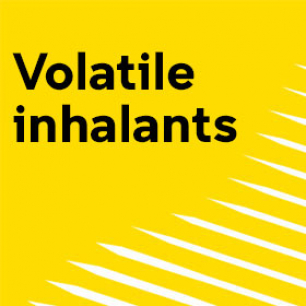What are volatile inhalants (volatile solvents)?
Volatile inhalant (also volatile solvent) misuse covers the inhalation of substances that vaporise at room temperature for the purpose of intoxication or sexual experience enhancement.
There are various types of inhalants that have different effects. They may be broadly categorised as:
- Gas fuels (cigarette lighter fluid, gas bottles)
- Petroleum
- Aerosol propellants (air fresheners, deodorant spray)
- Adhesives and paints (glue, spray paints)
- Volatile anaesthetics (nitrous oxide)
- Nitrites (amyl nitrite)
Inhalants are breathed in through the nose or mouth, typically by being placed in or on another object before being inhaled.
What are the effects?
Volatile inhalants have a rapid onset of effects that include:
- Initial rush or ‘high’
- Euphoria
- Depersonalisation
- Light-headedness
- Loss of consciousness
- Numbness of the body
What are the risks?
The risks of volatile inhalant misuse include damage to the brain, heart, kidneys and spine, as well as psychiatric problems.
Acute risks
- Suffocation (asphyxia)
- Fitting
- Swelling of the brain (cerebral oedema)
- Uneven heartbeat (cardiac arrythmia)
- Sudden cessation of breathing (acute respiratory arrest)
- Kidney failure
- Intense agitation that may result in harm to self or others
- Acute psychosis
- Low blood pressure
- Impaired memory
- Hallucinations
- Delusions
- Blackouts
- Headache
Chronic risks
- Atrophy of the brain
- Cardiomyopathy (heart chambers dilate causing reduced pumping efficiency)
- Spinal cord degeneration due to interference in the metabolism of vitamin B12
- Depression
- Incontinence
- Numbness in limbs
- Dependence
- Methemoglobinemia (a blood disorder)
- Macular degeneration (a disease that affects the back of the retina)
Toxicity and overdose
Volatile inhalant misuse may cause sudden sniffing syndrome, which is sudden collapse shortly after inhalation caused by cardiac and/or respiratory arrest that may result in death.
Dependence and withdrawal
When using inhalants, people may re-dose frequently as the effects are short-lasting and pleasurable. There is risk of dependence.
How many people use volatile solvents?
According to the Australian Institute of Health and Welfare, use of inhalants in the previous 12 months has been gradually increasing – from 0.4 percent in 2001 to 1.0 percent in 2016 and 1.7 percent in 2019. People who used inhalants used them quite frequently (compared to drugs such as ecstasy and cocaine), with 33 percent reporting at least monthly use.
The most common forms of inhalants used in 2019 were nitrous oxide and amyl nitrate and other nitrates (for example, poppers), used by at least six in 10 people who had used inhalants in the previous 12 months (AIHW, 2020).
Treatment
Most people seeking treatment for volatile inhalant misuse will receive help from community drug treatment services. The main types of services are:
- Residential rehabilitation (including therapeutic communities)
- Out-patient counselling
Emergency info
If you, or someone around you, is experiencing undesired or distressing psychological or physical symptoms from the intake of alcohol or other drugs please seek immediate medical attention.
If you need urgent help from ambulance services call Triple Zero (000). If a person has been mixing drugs with alcohol or other drugs, tell the paramedic exactly what has been taken.
Services
For free and confidential advice about alcohol and other drugs, call the National Alcohol and Other Drug hotline on 1800 250 015.
More resources
The Illicit Drug Reporting System is an Australian monitoring system that identifies emerging trends of local and national interest in illicit drug markets.
The Ecstasy and Related Drugs Reporting System is an Australian monitoring system for ecstasy and related drugs that identifies emerging trends of local and national interest.
The Clinician’s Guide to Illicit Drugs and Health examines the health effects of each of the major illicit drugs.
The Pocket Guide to Drugs And Health presents page at a glance informtion on the health effects of each of the major drugs.
The Australian Institute of Health and Welfare collects information on alcohol and tobacco consumption, and illicit drug use among the general population in Australia.
The Australian Bureau of Statistics is Australia’s national statistical agency, providing official statistics on a range of economic, social, population and environmental matters of importance to Australia.


